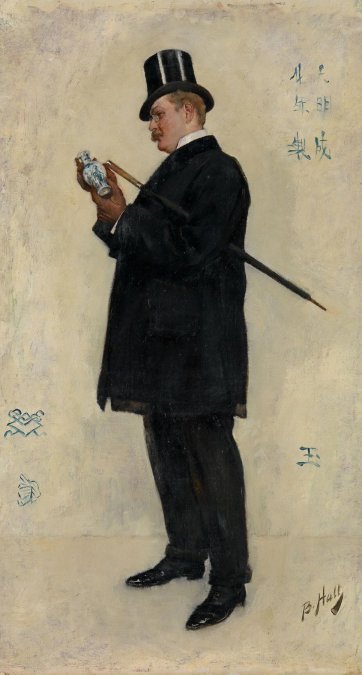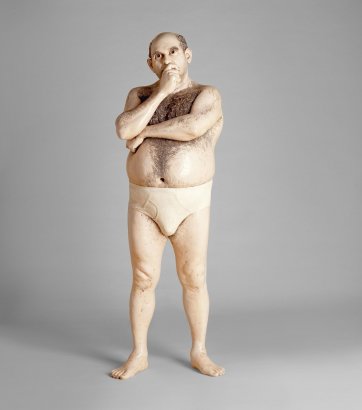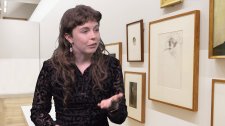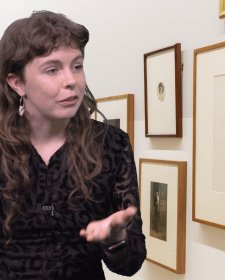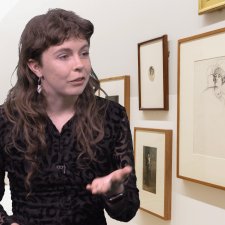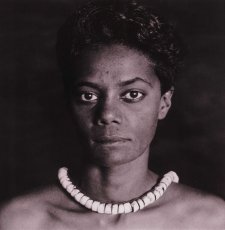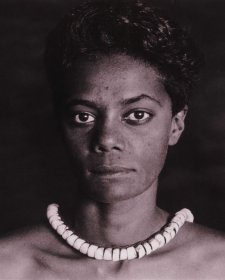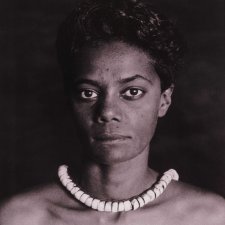- So Gill. I'm gonna introduce you to two connoisseurs. One has a lot of clothes on, and one really doesn't. Awesome.
- And so basically what we've got here are one sort of archetypal connoisseur, painted by Bernard Hall in 1890ish, just about two years before he started his directorship of the National Gallery of Victoria. And we've also got-
- That's probably why he has clothes on.
- Yes, yes, indeed. And we've also got Peter Corlett's very different connoisseur from 1984. So to introduce you to both of them. So starting with Bernard Hall's connoisseur. So this guy's like an archetypal connoisseur. We've got a beautifully rendered oil painting of him examining this vase very closely. So Bernard Hall came from that tradition. He studied painting at the Royal College of Art under Edward Pointer, and he became really that sense of, you know, extraordinary technique and craftsmanship got really drilled into him and it's something that he kept as sort of a value for his whole life. One of the other things he did as an artist was go to Munich where he formed a connection with the immediately past prior director of the NGV. Ah.
- A Mr. Folingsby. And when he passed away in 1891, the mantle went to Bernard. And so he arrived in Australia about two years after he painted this particular portrait. And he needed his connoisseurship. Because he had to advise the trustees on the purchase of art. And according to the ADB, one of his sort of famous things he used to say was that there was no immorality in art except bad technique.
- Ah.
- So you can see, it's a really nice sort of way of, I suppose, understanding that particular artist through his vision of the archetypal connoisseur. Now by stark contrast, you've got Peter Corlett's Connoisseur, and he had this beautiful way of expressing his aim with this particular sculpture, which was that he wanted to see what an intelligent man looked like thinking, while in his underpants. And I think he's, if that was his aim, I think he's definitely achieved that. He really, this work was quite interesting for him, because the previous work that he'd done often had this really kind of sardonic edge. But with this particular series in 1984, he was really looking to embrace a realism and a sense of portraiture. So he wanted this to be what he called a gentle warts-and-all portrait, that was closely observed. Which I think he also achieved. They're very, I think they're a lovely pair. So there's two really interesting things about bringing these into a portrait gallery. One of them is that it's a bit weirdly self-reflexive, 'cause you've got two people looking at art, and we're in there looking at art.
- Yeah, it's like, very inception, isn't it?
- Yeah, exactly. That is exactly what it's like. And also, because they're both from particular traditions of realism from their time, embedded in their time, the thing that's really emphasised in both of them is actually the artifice of that. Like what you sort of understand and respond to is a little bit, much more about the technique and how they're made, and you're interested in them because of their-
- Hairy chest.
- Yeah, that's it. The way they're made. That's exactly right. And so I think there's those two really interesting aspects. And the other reason I like them is because I remembered when we were going through this process, when we were curating the show, I remembered Ambrose Bierce's Devil's Dictionary definition of a connoisseur. Which is a specialist that knows everything about something, but nothing about anything else. But yeah, that idea of being that, the person who has the knowledge to judge something critically, is quite interesting in how you then analyse these works, because it's very intellectual. It's very mentally focused, and you sort of think with an art gallery, yes, you're bringing your brain. But actually what I think you discover from these portraits is something that we all have knowledge of. You don't need any expertise to bring a sense of your own body. But yeah, it's that sense of his body that comes to the fore, when you show these works together. And I think that's a really lovely reminder that when we come to a gallery, we bring our bodies as well as our minds.
- Well, when you strip it all away, we're all humans in our underpants, aren't we?
- That's exactly right. Even the most knowledgeable connoisseurs.
